A couple of years ago my husband & I, along with friends visiting from France, stopped at the Imagine Mosaic in Strawberry Fields in NYC’s Central Park. Surrounded by admirers of the former Beatle, John Lennon, there were also passersby who might not have even known this mosaic existed as a testament to his music and his memory. It was a beautiful sight. But it was also haunting as one can view The Dakota apartment building in the background where, as we all know, John Lennon was fatally shot on Dec 8, 1980.
In the center of this mosaic are the words Imagine- one of John’s most poignant songs and his Imagine 1971 album.
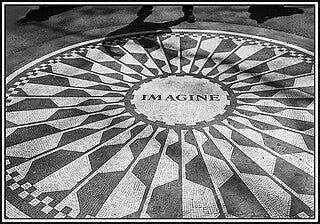
Inspired by ancient Greco-Roman mosaics
I chose this mosaic to begin my story as it is stunning in its imagery and certainly its meaning. I also chose it as it was inspired by ancient Greco-Roman mosaics.
Roman Mosaics were a “common feature of private homes and public buildings across the empire from Africa to Antioch. Not only are mosaics beautiful works of art in themselves but they are also an invaluable record of such everyday items as clothes, food, tools, weapons, flora and fauna.” Simply stated- mosaics are meant to serve as a decorative element; made up of closely set, b & w (like the Imagine Mosaic) but usually colored tiny pieces of stone, glass, tile, or shell which are set into a surface.
“It was not until Hellenistic times in the 3rd century BCE that mosaics really took off as an art form and detailed panels using tesserae rather than pebbles began to be incorporated into patterned floors. Many of these mosaics attempted to copy wall paintings.’
We’ve either learned about mosaics from antiquity or have actually seen some in museums. (Perhaps you even created a mosaic as a child in school or as an artist.) My guess is that many may think of mosaics as just artifacts from antiquity. Classic in style. But let me introduce you to another side to the ancients. Here are a couple of mosaics which show their strange and frivolous nature.

This first image is representative of a classic Roman mosaic from antiquity. But it makes one ponder- why this expression?
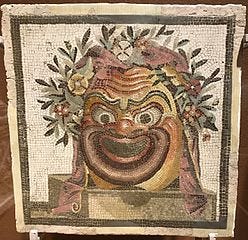
The second image depicts Salinus, a satyr in Greek mythology. A satyr is a lover of drink, dancing and woman. Physically it has ears and a tail resembling those of a horse and an exaggerated phallus. (Don’t shoot the messenger here- I’m only repeating what is written in history.)
My point is that ancient Greco-Roman mosaics were a lot more complex, bizarre, and even humorous in design and purpose than we might have imagined.
Speaking of bizarre…
I intentionally used the word “bizarre” as it is defined as: very strange or unusual, especially so as to cause interest or amusement- “(her) bizarre dresses and outrageous hairdos." Enter Medusa. In Greek mythology she started out as a beautiful mortal, charmed Poseidon, had her head severed by Perseus, who, in turn, gave it to the goddess Athena (wife of Poseidon.) Back to the outrageous hairdo- “Athena turned Medusa’s beautiful locks into snakes and made her face so terrifying that anyone who gazed upon her would be turned to stone.”
It is this image that also charmed us mere mortals to duplicate Medusa’s head in so many mediums. Even the Italian designer, Gianni Versace, was so enamored with her story that he made Medusa the Versace brand logo.

This leads me to one of my favorite examples of a micromosaic which I always shared with my decorative arts students. It is the Head of Medusa jeweled brooch. (A micro-mosaic uses particularly small glass mosaic pieces (tessarae) to make small figurative images.)
This Head of Medusa micromosaic gold brooch, measuring 1 1/2 x 2 13/16 inches, was made by the firm of Castellani- a notable house which made 19th century archaeological revival jewelry . Archaeological revival jewelry was very detailed, masterful in execution, and was “inspired by the excavations and discoveries of Roman, Egyptian, Hellenistic, and Etruscan sites” uncovered at that time in history
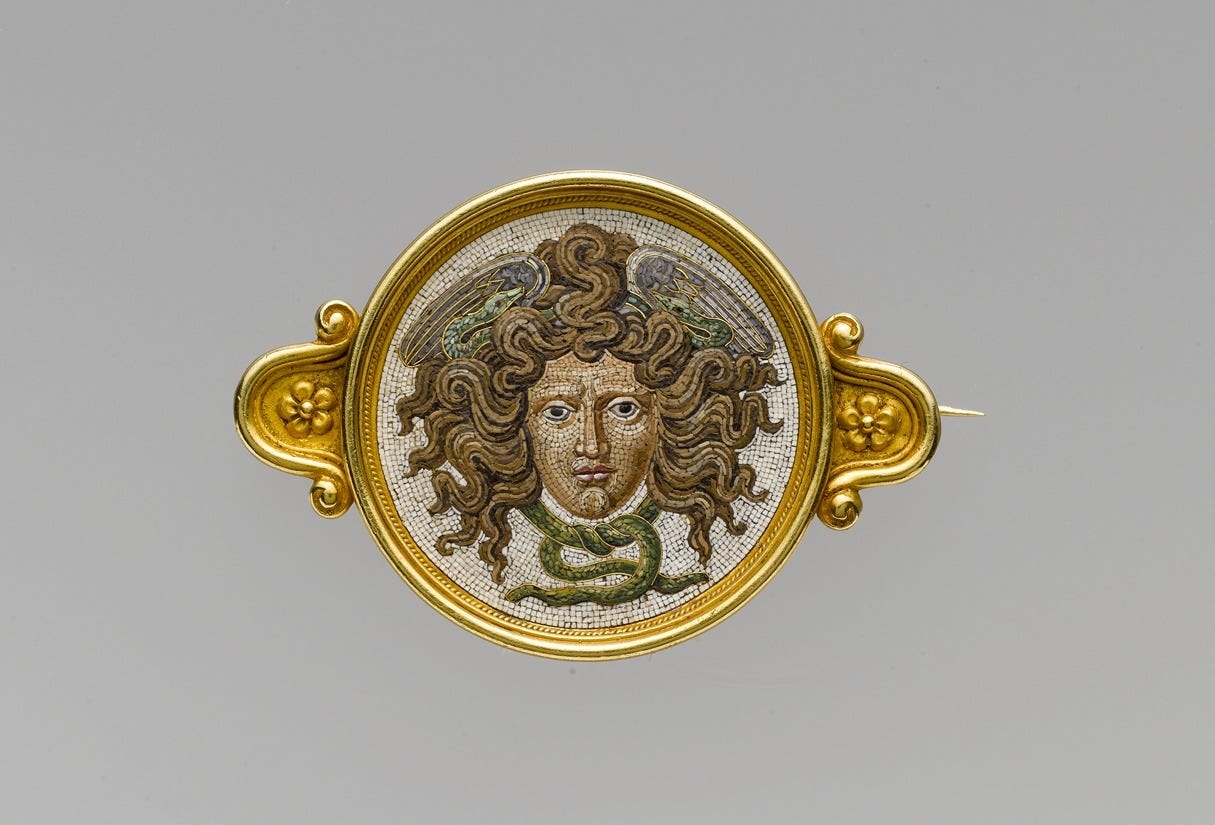
We can clearly see how this Head of Medusa micromosaic was inspired by the design- work of antiquity. The same can be said of the Imagine circular mosaic noted above.
But not all mosaics reflect this classic Greco-Roman style ~
Many mosaics took this artform to another level of thematic design, modernity and, in one case…another level of absurdity.
In the spirit of arts & culture…
My renewed interest in mosaics, and why I chose to write on this topic this week, was sparked by a visit last week to cousins living in the Fort Lauderdale, Fl area (whom I haven’t seen in a very, very long time.) My sister, Carolann, and I were treated to a boating trip. As we traveled through the Ft. Lauderdale harbor, on the side of the William H. Memorial Bascule Bridge was a Las Olas tile mosaic. It was bold, bright, lyrical and obviously it was touting the performing arts of Ft. Lauderdale.
Created by Diane Hutchinson in 2011, the Las Olas (meaning the waves) mosaic beautifully captures the colorful, theatrical, bustling vibe of Fort Lauderdale (and Las Olas Boulevard itself- the cultural and social hub of Fort Lauderdale.)
In the spirit of fun…
I would be remiss if I did not include a mosaic from the incomparable Art Nouveau 19th & 20th C. architect, Antoni Gaudi, Barcelona, Spain. I could write a whole narrative on Gaudi alone. But for the purposes of this curated newsletter, I will let these images tell his story (as does the link I provided.) Suffice to say that he was one of the most innovative architects who used interesting materials, color and whimsy to create structures that just makes one smile. His architectural masterpieces are veritable spirit boosters!
Here are two examples…
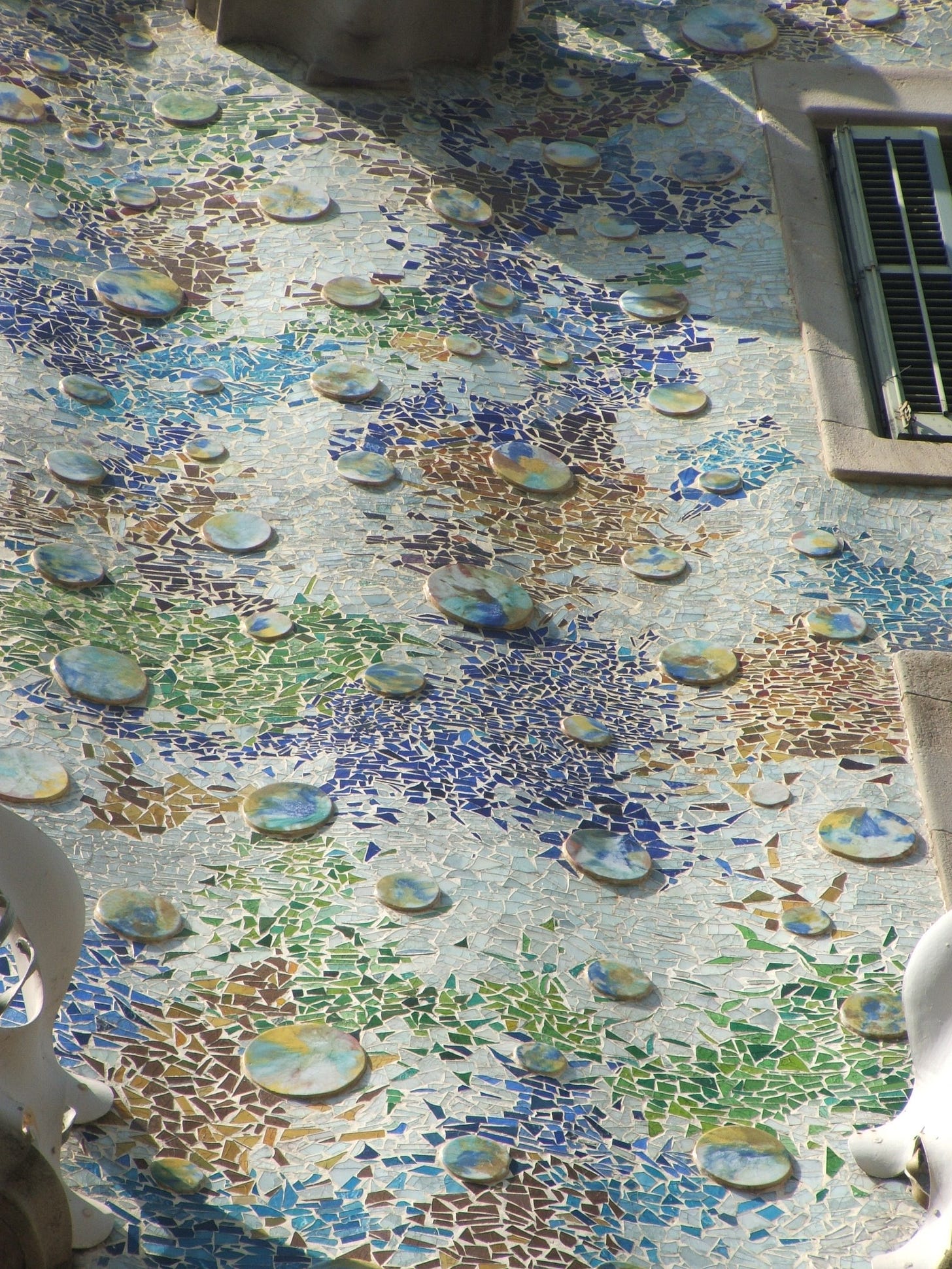
Look at how Gaudi uses mosaics in his Casa Battló exterior (above) to create a feeling of movement. Its interplay of soft colors scintillate the senses.

The whimsy continues in his Park Güell Banc de la plaça 7. I don’t know how to aptly describe Gaudi’s style except to say that it is inventive, eclectic, and alive!
My husband suggested two more mosaics that fall within the descriptive of fun, unique and downright strange. Unfortunately I’ve never seen either one. But as we’re talking “mosaics reimagined” and not classic, then, like Gaudi, these next two fit the bill. And they’re right here in the USA.
First, the Watts Towers, Los Angeles, Ca.


Built by Sabato (Simon) Rodia, in the years 1921-1954, the Watts Towers are 17 interconnected sculptural towers. Spanning many years to construct, one must conclude that the Towers were truly a labor of love for Rodia. Ornamented with a collage mosaic of broken glass, sea shells, pottery, figurines, and tile, there is also a wonderful interplay of color, like the Gaudi mosaics, but it is fused with all found objects!
In 1961 the Watts Towers transitioned to the Watts Towers Arts Center. It became a vibrant educational center offering classes in painting, sculpture, photography, music, dance, gardening, tiling, and other multi-media arts.
Fun fact- The Watts Towers appear in a multitude of films; the latest of which is the 2016 movie La La Land which shows the film's main characters, Mia & Sebastian, visiting the towers in a romantic montage sequence.
Next up….and we move into the very strange…the Main house at Luna Parc, Montague, NJ!
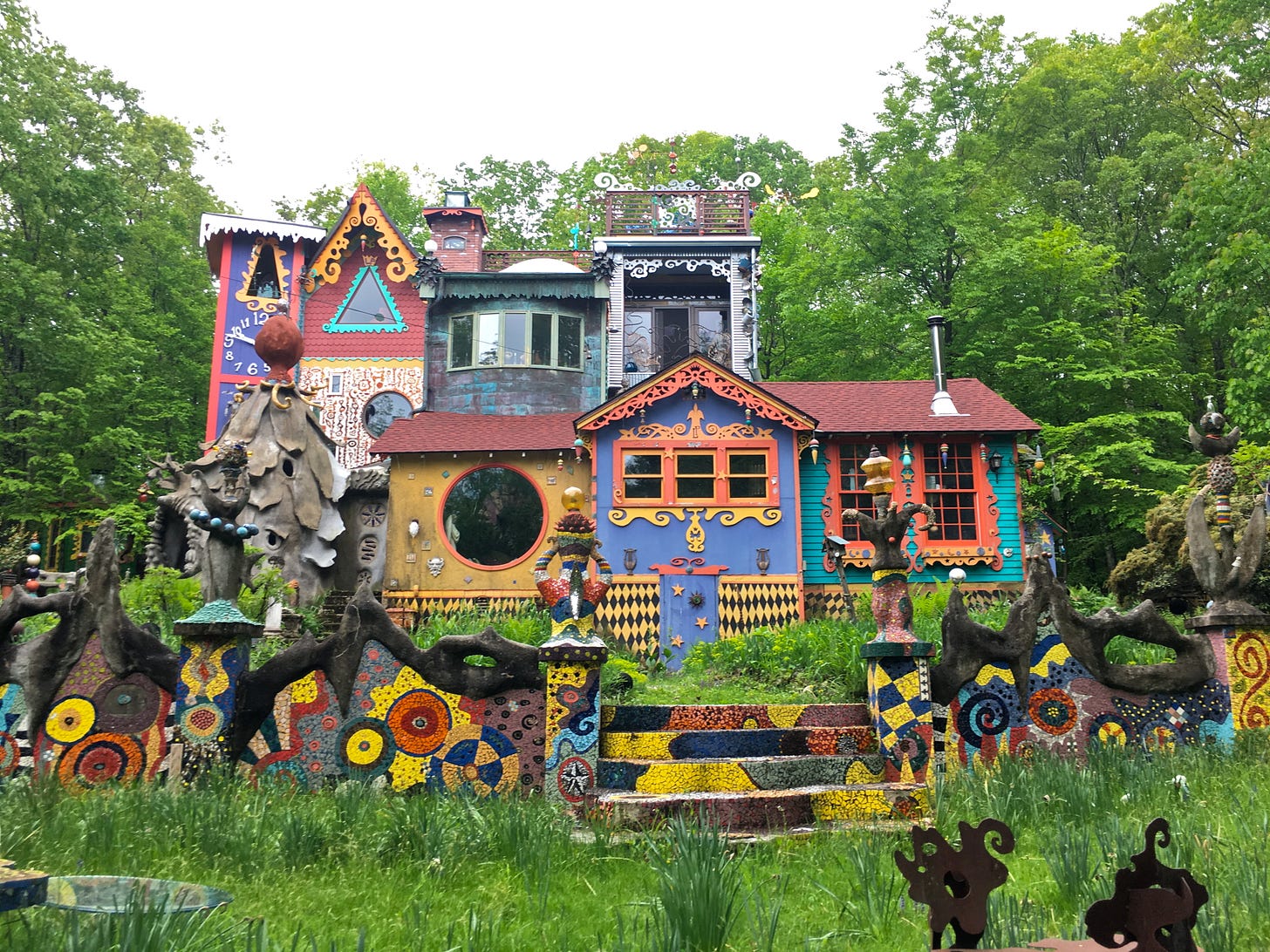
I think I’m just going to let this picture speak for itself. Construction for the house in Luna Parc, Montague, NJ, began in 1989 and is the private home of multimedia artist, Richard “Ricky” Boscarino. Let’s just say that it is a museum of art and oddities! You can see that it contains very colorful, random and (?)playful mosaic tiling. It is described in the book, Weird NJ, as a “Psychedelic Wonderland in the Woods.” Enough said.
In the spirit of modernity…
Artistry and drama abound in this in NYC subway tile, Elevated by Jean Shin

Commissioned by both the MTA Arts and Design and MTA New York City Transit, this mosaic subway tile was designed by artist, Jean Shin in 2016. It appears at the 2nd Ave Subway at 63rd Street Station in NYC. The mosaic tile is made of “dynamic materials of ceramic, mosaic and glass. While present-day commuters descend underground in the new subway station, the artwork transports them with images that capture the memory of riding the elevated.”
I left this tile mosaic for last as it is striking and thought-provoking. Its grey tones are reflective of the concrete NYC buildings and muted fashion colors on the streets of the city (unlike the vibrant colors we saw in the coastal city of Fort Lauderdale’s mosaic.) Elevated speaks to the way in which this artform -a mosaic- was reimagined to portray contemporary life in this urban city; once elevated, now underground. (A psychologist would have a field day analyzing the meaning behind this.)
You may prefer the Greco-Roman classic mosaics. You may prefer its contemporary counterparts. Whatever the case, creating mosaics takes vision, technical skill, and an intense level of concentration. One might say that making a mosaic harkens back to early 20th century Pointillists who used tiny, colored dots to create images on paintings. As we view these works of art, will they have profound meaning for us or will they just tickle our fancy?
Please subscribe to my free newsletter below. Comments are always welcome. Any mosaics you would like to share?




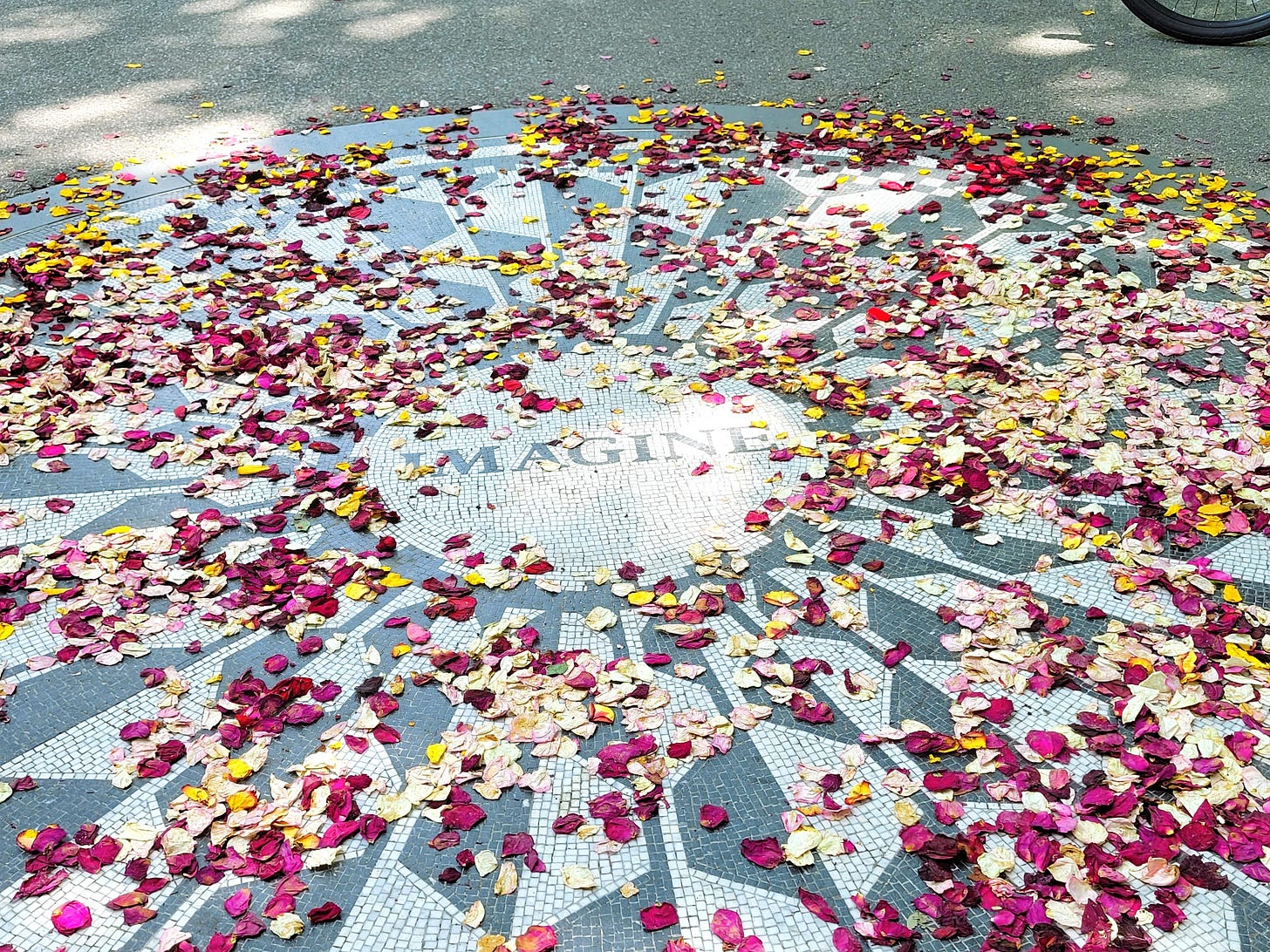

fascinating and beautiful subject. i have always loved mosaics. but did think of them as more ancient. nice to be made aware of contemporary ones! well done Donna!